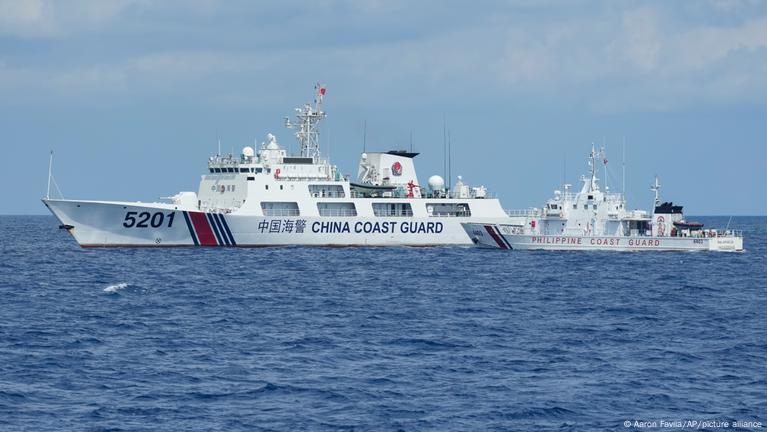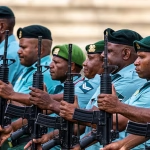The South China Sea has long been one of the most volatile maritime flashpoints in Asia, a body of water rich in resources, traversed by some of the world’s busiest shipping routes, and claimed by multiple nations with overlapping territorial interests.
- The Incident at the Shoal
- Historical Context of the Dispute
- Strategic Importance of the Shoal
- Regional Reactions and Global Implications
- Economic Stakes and Trade Routes at Risk
- Legal and Diplomatic Dimensions
- Military Balance and Power Projection
- Expert Opinions on the Collision
- The Role of the United States
- Future Scenarios and Possible Outcomes
- FAQs
- What caused the collision between Chinese and Philippine vessels?
- Why is the South China Sea so important?
- What was the 2016 arbitral ruling about?
- Could the U.S. get involved in the dispute?
- How does the dispute affect local communities?
- Is there a chance for a peaceful resolution?
- Conclusion
This week, tensions escalated once again as Chinese and Philippine vessels collided near a disputed shoal, raising fears of a wider confrontation between Beijing and Manila. The incident, while not entirely unprecedented, represents yet another reminder of how fragile peace is in this region and how close the world may be to a maritime crisis.
Maritime disputes in the South China Sea are not new, but the recent clash near the disputed shoal has taken on added significance. Both China and the Philippines have been locked in a longstanding territorial struggle over various shoals, reefs, and islands, but this latest confrontation comes at a time when regional alliances, global power competition, and economic stakes are at their peak. With Washington reaffirming its defense commitments to Manila, and Beijing refusing to scale down its assertiveness, the incident may well shape the next phase of regional geopolitics.
The Incident at the Shoal
The collision occurred in the early hours of the morning near a contested shoal that both nations claim as part of their exclusive maritime territory. According to reports from Philippine officials, one of their supply vessels was conducting a routine mission to deliver provisions to military outposts stationed on disputed features. During this operation, it was confronted by multiple Chinese coast guard and maritime militia vessels. Eyewitnesses claim that after a tense standoff involving water cannon blasts, radio warnings, and close maneuvers, a direct collision between one Chinese vessel and a Philippine supply boat took place.
Manila quickly accused Beijing of reckless and aggressive behavior, pointing to what it described as a deliberate ramming designed to intimidate Philippine forces. China, however, offered a starkly different narrative, stating that the Philippine vessel had “illegally entered Chinese waters” and “provoked the confrontation” by ignoring lawful instructions. These dueling accounts underscore the depth of mistrust between the two nations and highlight the difficulty of establishing an objective truth in such incidents.
Historical Context of the Dispute
To fully understand the gravity of the situation, it is important to revisit the broader territorial dispute. The South China Sea is believed to contain vast reserves of oil and natural gas, along with some of the world’s richest fishing grounds. For decades, China has asserted what it calls “indisputable sovereignty” over nearly the entire sea, demarcated by its infamous nine-dash line. This claim, however, overlaps with the exclusive economic zones (EEZs) of multiple Southeast Asian nations, including the Philippines, Vietnam, Malaysia, and Brunei.
The Philippines has long challenged China’s sweeping claims. In 2016, Manila won a landmark case at the Permanent Court of Arbitration in The Hague, which ruled that China’s nine-dash line had no legal basis under international law. While hailed as a major diplomatic victory for the Philippines and other claimant states, China flatly rejected the ruling and continued to expand its physical and military presence in the region by building artificial islands, installing military facilities, and deploying coast guard and militia ships.
Against this backdrop, the latest collision is not just a maritime accident but the continuation of a simmering conflict where legal rulings, diplomatic protests, and international norms often clash with brute force and realpolitik.
Strategic Importance of the Shoal
The disputed shoal where the collision took place holds immense strategic importance. Its location near critical sea lanes makes it a valuable maritime asset. It also provides access to abundant fishing grounds that sustain local communities. More importantly, it serves as a strategic outpost for controlling movement in the South China Sea. For the Philippines, maintaining a presence near the shoal is a matter of sovereignty and national dignity. For China, preventing Manila from solidifying its foothold is crucial to asserting its dominance in the region.
Military analysts point out that control of such shoals is not just about resources but also about the ability to project power. A shoal that can host surveillance systems, radar installations, or even temporary supply stations can significantly alter the balance of power in contested waters. This explains why both sides are unwilling to make concessions, even at the risk of escalating tensions.
Regional Reactions and Global Implications
The collision has already sparked a wave of reactions across Asia and beyond. Vietnam and Malaysia, themselves locked in disputes with China, expressed solidarity with the Philippines, warning that unchecked Chinese actions could destabilize the entire region. The United States, under its Mutual Defense Treaty with the Philippines, reiterated its “ironclad” commitment to defend Manila in the event of an armed attack. Washington condemned what it described as “dangerous maneuvers” by China and called for respect of international law and freedom of navigation.
Japan and Australia also voiced concern, stressing the importance of preserving peace and stability in one of the world’s most vital maritime corridors. Analysts suggest that if incidents like these continue, they could draw in a wider coalition of countries seeking to deter China’s assertiveness, thereby increasing the risk of great-power confrontation.
From Beijing’s perspective, external involvement is seen as unwelcome interference. Chinese state media has already accused the United States of instigating tensions by encouraging Manila to resist Beijing’s maritime claims. This narrative resonates with China’s long-standing portrayal of the South China Sea dispute as an internal regional issue rather than a matter for international arbitration or intervention.
Economic Stakes and Trade Routes at Risk
Beyond politics and security, the South China Sea dispute carries immense economic stakes. Roughly one-third of global shipping—worth over $3 trillion annually—passes through these waters. Any sustained conflict or instability could disrupt supply chains, raise shipping insurance costs, and create ripple effects across global markets. Energy companies, fishing industries, and even technology supply chains depend heavily on safe passage through these sea lanes.
Experts note that escalating confrontations could also deter foreign investment in Southeast Asia. Already, regional economies have faced uncertainty due to rising U.S.-China trade tensions, and further instability in the South China Sea could compound these challenges. For local fishermen in the Philippines, the dispute is deeply personal, as Chinese vessels often block access to traditional fishing grounds, threatening livelihoods that have existed for generations.
Legal and Diplomatic Dimensions
At the diplomatic level, the Philippines has consistently raised the dispute in international forums, appealing to the United Nations, ASEAN, and global partners for support. While ASEAN as a bloc has struggled to adopt a united stance due to varying national interests, there have been growing calls for a binding Code of Conduct to regulate activities in the South China Sea. Negotiations between China and ASEAN on this framework have dragged on for years, with little substantive progress.
International law provides Manila with strong legal standing, especially given the 2016 arbitral ruling. However, enforcement remains elusive. China’s refusal to abide by the ruling highlights a fundamental weakness in international law: it lacks mechanisms for enforcement against powerful states. This reality forces the Philippines and its allies to rely on diplomatic pressure, public opinion, and strategic partnerships to counterbalance China’s military superiority.
Military Balance and Power Projection
The collision also brings into focus the stark military imbalance between China and the Philippines. China boasts one of the world’s largest coast guard fleets, a powerful navy, and an extensive network of maritime militia vessels. The Philippines, by contrast, has a relatively modest naval capability, relying heavily on support from allies like the United States and Japan.
In recent years, the Philippines has modernized parts of its navy and coast guard, acquiring new patrol vessels and aircraft. Still, experts caution that Manila’s ability to defend its maritime claims remains limited without external support. This imbalance emboldens China to pursue aggressive tactics, such as ramming, water cannon attacks, and encirclement, which fall short of outright warfare but exert immense pressure on weaker claimants.
Expert Opinions on the Collision
Maritime experts have warned that collisions of this nature are increasingly likely as both sides adopt hardline positions. Professor Jay Batongbacal, a leading maritime law scholar in the Philippines, described the incident as “a dangerous escalation of gray-zone tactics designed to intimidate without triggering outright war.” Meanwhile, Chinese analysts argue that Manila is “playing with fire” by aligning too closely with Washington and provoking Beijing at a sensitive moment in regional affairs.
International security scholars highlight the risks of miscalculation. “Even a minor collision can spiral out of control in contested waters where military and paramilitary forces operate in close proximity,” said Dr. Euan Graham of the International Institute for Strategic Studies. “The danger is not just accidental escalation but the possibility of deliberate actions being misinterpreted as accidents.”
The Role of the United States
One of the most critical aspects of the dispute is the role of the United States. Under the 1951 Mutual Defense Treaty, Washington is obliged to come to Manila’s aid if its armed forces or public vessels are attacked in the Pacific. U.S. officials have repeatedly clarified that this commitment extends to the South China Sea.
For the Philippines, U.S. support serves as a vital deterrent against Chinese aggression. For China, however, U.S. involvement is viewed as a strategic encirclement designed to contain its rise. The presence of American military bases, joint exercises, and freedom of navigation operations adds layers of complexity to an already volatile situation.
Future Scenarios and Possible Outcomes
The immediate future of the South China Sea dispute will depend on how both nations choose to handle the aftermath of the collision. Several scenarios are possible. The first is continued escalation, with more aggressive confrontations leading to a potential military standoff. The second is managed tension, where both sides continue to clash but avoid outright war, relying on diplomacy to manage the fallout. The third, though less likely, is a breakthrough in negotiations leading to a binding agreement on conduct and resource-sharing.
For now, experts lean toward the second scenario. Both sides recognize that war would be catastrophic, but neither is willing to back down completely. This delicate balance ensures that the South China Sea will remain a hotspot for international concern.
FAQs
What caused the collision between Chinese and Philippine vessels?
The collision occurred during a resupply mission by Philippine forces near a disputed shoal. Manila claims that a Chinese vessel deliberately rammed its ship after aggressive maneuvers, while Beijing insists the Philippine vessel illegally entered Chinese waters.
Why is the South China Sea so important?
The South China Sea is vital due to its abundant natural resources, including oil, gas, and fisheries. It is also one of the busiest maritime trade routes in the world, with around one-third of global shipping passing through it annually.
What was the 2016 arbitral ruling about?
In 2016, the Permanent Court of Arbitration ruled in favor of the Philippines, stating that China’s nine-dash line had no legal basis under international law. The ruling invalidated many of China’s claims, but Beijing rejected the decision and continued its activities in the region.
Could the U.S. get involved in the dispute?
Yes, under the Mutual Defense Treaty, the United States has pledged to defend the Philippines if its armed forces or public vessels are attacked in the Pacific, which includes the South China Sea. This makes U.S. involvement highly possible if hostilities escalate.
How does the dispute affect local communities?
For many Filipinos, especially fishermen, the dispute is deeply personal. Access to traditional fishing grounds has been restricted by Chinese vessels, threatening their livelihoods and cultural traditions.
Is there a chance for a peaceful resolution?
While difficult, a peaceful resolution is possible through sustained diplomacy, international pressure, and regional cooperation. Efforts like ASEAN’s proposed Code of Conduct could provide mechanisms for reducing tensions, though progress has been slow.
Conclusion
The collision between Chinese and Philippine vessels near a disputed shoal in the South China Sea is more than a maritime incident—it is a reflection of a deeper struggle over sovereignty, resources, and regional influence. It underscores the fragile balance between diplomacy and confrontation, law and power, small states and great powers.
As the Philippines stands firm on its rights under international law and China asserts its expansive claims, the stakes extend far beyond the two nations. The outcome will shape not only regional stability but also the future of international order in one of the most critical waterways on Earth.








